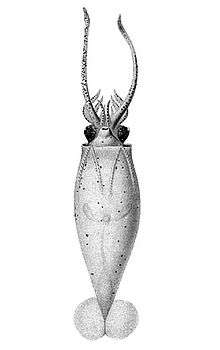Liocranchia
Liocranchia is a genus of glass squid from the family Cranchiidae. They are moderate-sized with a long, spindle-shaped mantle which tapers to a point at the rear and they can attain mantle lengths of 250 mm.[2] The species in Liocranchia have a cosmopolitan distribution in tropical and subtropical oceans although it has been suggested that on especies, Liocranchia reinhardti is associated with land masses. In seas off Hawaii waters L. reinhardti undergoes vertical migrations while L. valdiviae occurs in deep water is sedentary.[3] They are eaten by many oceanic predator species.[2]
| Liocranchia | |
|---|---|
 | |
| Liocranchia valdiviae subadult | |
| Scientific classification | |
| Kingdom: | Animalia |
| Phylum: | Mollusca |
| Class: | Cephalopoda |
| Order: | Oegopsida |
| Family: | Cranchiidae |
| Subfamily: | Cranchiinae |
| Genus: | Liocranchia Pfeffer, 1884 |
| Type species | |
| Leachia reinhardti Steenstrup, 1856[1] | |
| Species | |
|
see text | |
| Synonyms[2] | |
|
Fusocranchia Joubin, 1920 | |
Characteristics
Liocranchia species are characterised by having two rows of cartilagenous tubercules starting at each funnel-mantle fusion which diverge from each other along their length, each funnel having a valve and a very large ventral pad. The tentacles have duckers and pads in two series on distal 2/3 of tentacle stalk. In the paralarvae the eyes are not mounted on a stalk. The fins merge posterior to gladius and they are almost circular in their combined shape. There are a number of oval photophores on each eye and this varies with species 4 in L. valdiviae and 14 in L. reinhardti. There are also photophores on the tips of arms III in adult or subadult females.[3] The males bear suckers in 2 rows on the middle part of the hectocotylized right or left arm IV.[2]
Species
The genus Liocranchia consists of two valid species and one questionable species:[1]
- Liocranchia gardineri * Robson, 1921
- Liocranchia reinhardti (Steenstrup, 1856)
- Liocranchia valdiviae Chun, 1910
The species listed above with an asterisk (*) is a taxon inquirendum and needs further study to determine if it is a valid species or a synonym.[1]
References
- Julian Finn (2016). "Liocranchia Pfeffer, 1884". World Register of Marine Species. Flanders Marine Institute. Retrieved 27 February 2018.
- P. Jereb; C.F.E. Roper, eds. (2010). Cephalopods of the World an Annotated and Illustrated Catalogue of Cephalopod Species Known to Date Volume 2 Myopsid and Oegopsid Squids (PDF). Food and Agriculture Organization Rome. p. 156. ISBN 978-92-5-106720-8.
- Richard E. Young; Katharina M. Mangold (1922-2003) (1996). "Liocranchia Pfeffer 1884". Tree of Life Project. Retrieved 27 February 2018.